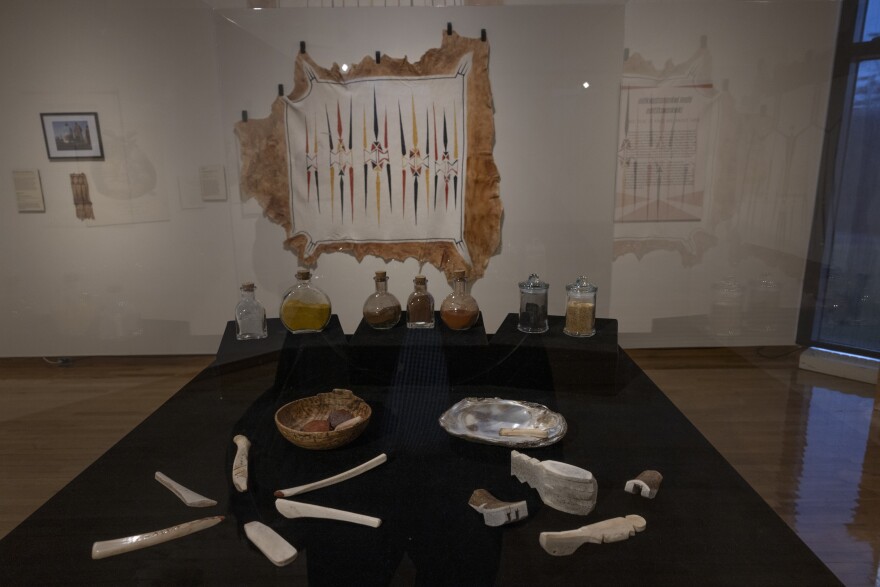A recently opened exhibit in Oxford explores the practice of creating painted deerskin hides by the Miami and Peoria tribes of Oklahoma. It's a first-time collaboration between the Richard and Carole Cocks Art Museum at Miami University and the Peoria Tribe, in collaboration with the Miami Tribe of Oklahoma. The exhibit is called, Minohsayaki ‘Painted Robes’.
"The Minohsayaki exhibit is the attempt of a team of people from the Miami Tribe of Oklahoma, the Peoria Tribe of Oklahoma and non-tribal scholars telling a story of our work thus far in bringing back the painting of hide robes to our communities," explains George Ironstrack, a citizen of the Miami Tribe of Oklahoma and assistant director of the Myaamia Center at Miami University.

He considers the exhibit a good way of providing a contextualized example of how items in a museum are more than just objects. They "connect to the stories that people continue to tell in our communities, but also to ongoing work to return knowledge and return practices to our community."
RELATED: This parent reclaimed her heritage because of where her son went to college
"In many ways, we feel like we're interacting with our ancestors when we're interacting with these historic objects," he says.
About minohsayaki
Pre-contact (prior to Europeans coming to the Americas) Peewaaliaki (Peoria) and Myaamiaki (Miami) artists practiced the art of decorating deer hides. Creating minohsayaki "painted hide robes" was popular from the late 1600s through the early 1700s. The museum states the practice declined in the mid-1700s.
Minohsayaki, pronounced mih-NOH-seye-YAW-kay, is the plural form, meaning "painted hide robes." Minohsaya, pronounced mih-NOH-seye-uh, is the singular, "painted hide robe."
The work draws from an exhibit of hide robes displayed at the Musée du Quai Branly - Jacques Chirac in Paris, France. The artifacts there were acquired by colonizers from Illinois-based tribes during the 1600s and 1700s and are similar to what Miami and Peoria peoples would have been creating during the same time.

"The minohsaya that are cared for in Paris at the Musée du Quai Branly are ... they label them 'Illinois,' and the Peewaalia (Peoria) are the contemporary representation of the the Illinois people today," Ironstrack explains.
Various Miami and Peoria artists have been reclaiming and relearning how to create minohsayaki. It's part of a larger inter-tribal, interdisciplinary effort. Ironstrack says the art form comes from the traditional homelands of the Myaamia and Peewaalia peoples, and begins with a relationship with the animal, many of which are deer, though elk and bison hide robes have also survived.
RELATED: The Miami Tribe's partnership with Miami University helps revive 'silent stories'
"The art form begins with the hunting of the animal in a cultural way, and the processing of the hide in a way that produces a high quality surface for painting but also for wearing, and then it moves to the creation of the pigments that are necessary for applying designs to these hides," he says. "Then the last stage that everyone sort of focuses on but it's actually the last of the process, is the creation of really beautiful designs on these hides, usually by the women of the communities in the past."
He says many of the designs on the hides in Paris are believed to be connected to stories still told in Miami and Peoria communities today.
Ironstrack says the hides in Paris are assumed to have been gifts to the French, they have been well cared for, and the museum has been a very good host when Miami and Peoria citizens have visited.
The exhibition is supported by a grant from Humanities Without Walls at the University of Illinois at Urbana-Champaign, and is part of the Reclaiming Stories project.
The exhibit runs through June 8, 2024.



